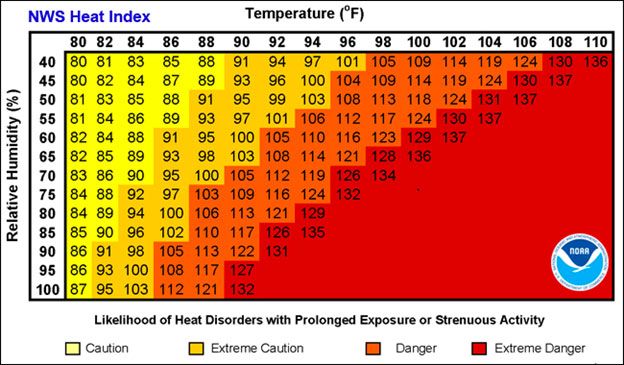Wet-bulb and Dry-Bulb Temperature Methods
Wet-bulb is a method of measuring air temperature where the thermometer is enclosed in a water-soaked cloth which is exposed to air. Wet-bulb temperature uses this method to measure how much water vapor the atmosphere can hold at the current weather and air pressure conditions. Evaporation of the water causes a cooling effect. Dry air with less humidity will cause the water to evaporate faster. Water can only evaporate if the surrounding air can hold more water, so if the relative humidity of the air is 100%, no more evaporation can happen. Evaporation is needed for sweat to be able to lower human body temperature on hot days.
Dry-bulb temperature is what we usually use to refer to the measurement of ambient air temperature. This is the most commonly used form of measuring air temperature; it is simply the temperature of outdoor air as measured by a thermometer. At 100% relative humidity, wet-bulb and dry-bulb temperatures are equal. At lower humidities, wet-bulb temperature is lower than dry-bulb due to the effect of evaporative cooling.
Wet-bulb temperature is a measurement that accounts for both heat and humidity. A wet-bulb temperature above 90 degrees Fahrenheit or 32 degrees Celsius is the limit for humans to perform outdoor activities. Humans cannot survive for more than a few hours beyond 90 degrees Fahrenheit wet-bulb temperatures, even with unlimited water and shade. And yet, climate change has already caused some areas of the earth, in the Persian Gulf and Pakistan, to cross above 95 wet-bulb degrees. These lethal conditions make it very important to think about the combination of temperature and humidity for climate projections, such as those used by the ClimateCheck heat rating.
Measuring Heat and Humidity
Robert G. Steadman created the heat index in 1979. The Heat Index is a measurement tool that indicates what the temperature feels like for the human body when relative humidity is factored into the measurement of air temperature. Like the measurement of wet-bulb temperature, the human body uses the process of sweating to cool the body through evaporation. If the relative humidity is too high, humans are not able to perspire enough to effectively cool themselves off.
The heat index is based on an average human, so it makes assumptions about body mass, height, heat tolerance, clothing, overall health and more. This is not always accurate. For example, studies have shown that sweating capacity is lower in women than men, and lower for older people compared to younger age groups. In addition, measurements of temperatures on the heat index chart are for shady locations, when exposed to direct sunlight, values for the heat index can increase by more than 15 degrees F.

The WetBulb Globe Temperature (WBGT) is another measure of heat stress used for managing the amount of time workers can be outside on hot days. It takes into account temperature, humidity, windspeed, sun angle, and cloud cover (the amount of solar radiation). In contrast to the heat index, it calculates temperatures in direct sunlight. The ability to sweat in direct sunlight is essential for anyone that spends time outside in summer heat. The WBGT is used to manage workloads for military agencies, OSHA, and many international organizations.
The combination of humidity and extreme heat can be especially dangerous. It can cause heat stroke, dehydration, and other serious health problems. Extreme temperatures present numerous risks, especially to those that are vulnerable to heat and humidity or those that live in locations that are not used to dealing with extreme heat. Heat kills more people than any other type of natural disaster in the U.S. in the average year.
ClimateCheck Use of Wet-bulb Temperatures
In our analysis, wet-bulb provides an important addition to the tools we use to measure heat. Our rating is based on the frequency and intensity of extreme heat days according to both dry-bulb and wet-bulb temperatures. Our rating is based on the temperature and frequency of the highest wet-bulb and dry-bulb days. We use both historical data and data projected through the year 2060 to model heat risk, as measured by these quantities. We then project each measurement onto a scale of 1-100, and use the cumulative distribution function of the sum of these four quantities for our final heat rating. In summary, the ClimateCheck extreme heat risk rating incorporates:
- The 2050 dry-bulb temperature of the hottest days in a location (dry-bulb intensity)
- The 2050 wet bulb temperatures on the most hot and humid days in a location (wet-bulb intensity)
- The projected number of extreme heat days in 2050 (dry-bulb and wet-bulb frequencies)
By including all of these factors, the ClimateCheck heat risk rating can help indicate where temperatures will be dangerous to human health and pose increasing costs to property. ClimateCheck ratings represent both relative and absolute changes in extreme heat, which means that they can be used to clarify which areas of the U.S. will experience more humid, hot days and how intense they will be. Adapting to climate change is especially important in locations that haven’t historically had a serious heat problem. These places do not yet have the infrastructure to protect people from the demands of heat waves. Many cities will have to evaluate their capacity for resiliency. This will include considerations such as whether their power grid will be able to sustain energy needs for air conditioning throughout the summer.
Conclusion
The frequency of extreme heat waves has risen in recent years, causing many to grow concerned about how rising temperatures will affect the human body. Humidity, which is measured by wet-bulb, is a key part of measuring the safety of climate conditions for human health. Many resources for climate data, including ClimateCheck, use wet-bulb as a measurement of heat. This is crucial for providing cities and healthcare systems forewarning to build up infrastructure to deal with heat illnesses.